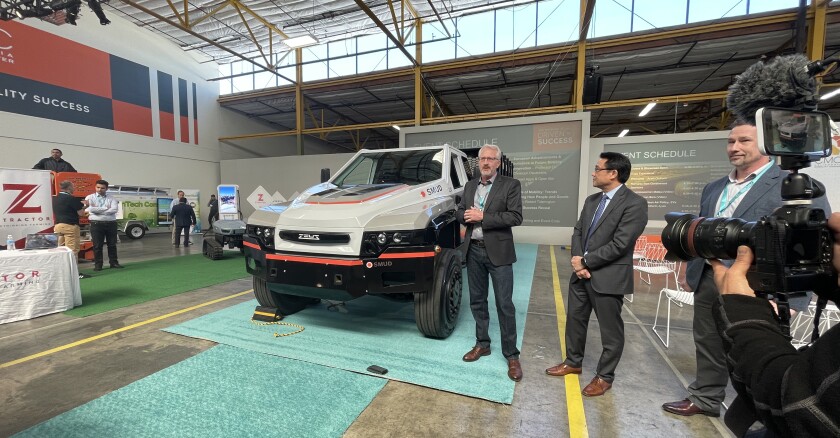The move on the part of the California Air Resources Board (CARB) would affect public and private fleets, as well as vehicles like drayage trucks serving ports and delivery vehicles operated by carriers like UPS, FedEx and the U.S. Postal Service, as the state moves forward on a trailblazing path away from fossil fuels.
“Despite the progress we’ve made, meeting California’s public health, air quality, environmental justice and climate goals requires more emissions reductions than we can get from combustion-based strategies,” said Liane Randolph, chair of the California Air Resources Board, in some of her comments during the CARB meeting Oct. 27. “To meet our goals we need to transition all feasible applications to zero-emission vehicles as soon as possible.”
The proposed rule, came before the state’s regulatory agency for the first time. It will get another hearing in several weeks, with plans to be approved in spring 2023. The policy includes several key components. Public fleets would be required to purchase zero-emission vehicles as an increasing percentage of vehicle purchases, following normal purchasing patterns. Also, drayage trucks would continue operating existing trucks “throughout their useful life,” but would be required to transition to ZEV by 2035, said CARB Executive Officer Steven Cliff.
Private fleets operating 50 or more vehicles and federal fleets would have two compliance options. “They could comply by removing combustion vehicles at the end of their useful life, and by only adding ZEVs to their fleets,” Cliff explained. “Or, they could elect to use an option to phase in zero-emission vehicles as an increasing percentage of their fleet, that can provide more flexibility in how the fleet is managed.”
The requirements would apply to any light-duty parcel delivery vehicles, like those operated by the USPS and other carriers like FedEx or UPS.
Some CARB members, and the dozens of environmental justice supporters commenting on the proposed rule Oct. 27, pressed for lowering the threshold from 50 vehicles to 10 or 20.
“I’m not sure why we’re not going down to five trucks,” remarked CARB member Diane Takvorian, following hours of testimony and comments from the public and industry.
Fellow CARB member Daniel Sperling, who serves as the director of the Institute of Transportation Studies at the University of California, Davis, pumped the brakes on that idea.
“The fleet purchase part makes me really nervous. Bringing it down to 10 vehicles makes me really nervous,” said Sperling, who would go on to describe this move as a “disaster.”
Some of Sperling’s concerns revolved around the question of whether enough electric trucks would be available and the robustness of the charging infrastructure.
“What we’re doing is going to be incredibly disruptive to many businesses, to many companies,” Sperling added.
Response to the proposed rule change took the expected routes of both praise and concern, as environmental and social justice groups urged approval of the rule change — even if many did not see the requirement as going far enough. While many fleet operators wondered about the availability of charging infrastructure.
The Advanced Clean Fleets (ACF) regulation, as the proposed policy is known, follows other steps taken by CARB to transition the transportation sector. In 2020 CARB approved the Advanced Clean Trucks rule, which requires truck makers to begin producing zero-emission medium- and heavy-duty trucks. The Clean Fleets rule would move up the time frame for when 100 percent of medium- and heavy-duty trucks sold in California must be zero emission from 2045 to 2040. And then earlier this year, CARB adopted another set of vehicle regulations to require that all new car sales in California be zero emission by 2035.
The policies are designed to both achieve climate and air-quality goals in the state, as well as help to nudge the entire vehicle industries toward a new electric future. The steps taken by California have been praised by officials from other states, already committed to following the Golden State’s lead.
The ACF will help to build up supply chains, said Tracy Babbidge, acting deputy commissioner at the Connecticut Department of Energy and Environmental Protection, and co-vice president on the board of directors for the National Association of Clean Air Agencies, “thus accelerating the emissions reductions attainable from clean zero-emission medium- and heavy-duty vehicles.”
“A rapid and equitable transition to zero-emission trucks and buses is critical to avoid the worst impacts of climate change, and improve air quality and public health outcomes in our communities,” echoed Jeremy Hunt, policy adviser and analyst at NESCAUM, a nonprofit association of state air quality agencies across New England.
Across the United States, medium- and heavy-duty vehicles represent 5 percent of vehicles on the roadways, but account for 30 percent of GHG emissions, 42 percent of NOx emissions and 51 percent of fine particulate matter emissions, said Hunt.
The proposed new Clean Fleets rule includes a number of carve-outs and exemptions in cases where there is no zero-emission vehicle readily available. Also, the rule exempts emergency vehicles like fire trucks and police cars. Rural counties and municipalities would be given more time to comply with the changes. Still, the vast diversity of California was not lost on CARB members.
Rural communities are “having anxiety about the future, and this rule in particular,” said Davina Hurt, a member of CARB and former mayor of Belmont, Calif.
“For some of these communities, they’re going to need a huge upgrade. And that costs a lot of money. And so there needs to be the investment from the state level to be able to support those communities,” said Hurt.
For all of these proposed exemptions, and other accommodations, at least some members of the state’s regulatory agency were not so sure the policy is ready for approval in its current form.
“This really needs some work,” remarked Dean Flores, a CARB member and former member of the California Legislature, who had concerns about polluting internal combustion vehicles still finding their way to some of the poorest communities.









